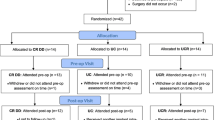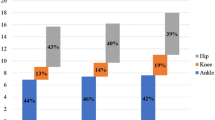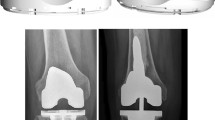Abstract
Purpose
The aim of this study was to quantitatively evaluate gait parameters in patients who underwent a revision procedure after an interval articulated spacer for septic knee prosthesis.
Methods
Ten adult subjects underwent three-dimensional computerized gait analysis 12 months after second-stage knee revision procedure. Kinematic and kinetic parameters were acquired and compared with a normal reference population. Data were also compared with those collected in a previous study, in which the same cohort of patients underwent gait analysis 8–14 weeks after spacer implantation.
Results
Kinematic and kinetic parameters did not show any significant difference between the affected and unaffected limb. Compared to normal reference population, patients treated with revision knee prosthesis showed a reduced mean gait velocity, step frequency, stride and step length, average knee range of motion, knee power and ground reaction forces. When comparing average data with those observed after spacer implant, no difference was observed in kinematic variables, while kinetic analysis demonstrated a significant improvement in knee power.
Conclusions
This study shows that 1 year after second-stage knee revision surgery, kinematic and kinetic values remain lower than those observed in a normal reference population. Only slight improvements in walking ability are shown, when analysing data in comparison with those collected after a preformed articulated knee spacer. This finding points out the long time to full functional recovery after knee revision surgery and the limited improvement of gait when compared to the one achieved at the time of spacer implant.





Similar content being viewed by others
References
Barrack RL, Engh G, Rorabeck C, Sawhney J, Woolfrey M (2000) Patient satisfaction and outcome after septic versus aseptic revision total knee arthroplasty. J Arthroplasty 15:990–993
Bellamy N (2005) WOMAC osteoarthritis index user guide. Version VII. Brisbane, Australia
Calton TF, Fehring TK, Griffin WL (1997) Bone loss associated with the use of spacer blocks in infected total knee arthroplasty. Clin Orthop Relat Res 345:148–154
Davis RB, Ounpuu S, Tyburski D, Gage JR (1991) A gait analysis data collection and reduction technique. Hum Mov Sci 10:575–587
Durbhakula SM, Czajka J, Fuchs MD, Uhl RL (2004) Antibiotic-loaded articulating cement spacer in the 2-stage exchange of infected total knee arthroplasty. J Arthroplasty 19:768–774
Emerson RH Jr, Muncie M, Tarbox TR, Higgins LL (2002) Comparison of a static with a mobile spacer in total knee infection. Clin Orthop Relat Res 404:132–138
Engh GA, Ammeen DJ (1999) Bone loss with revision total knee arthroplasty: defect classification and alternatives for reconstruction. Instr Course Lect 48:167–175
Engh GA, Parks NL (1997) The management of bone defects in revision total knee arthroplasty. Instr Course Lect 46:227–236
Ewald FC (1989) The knee society total knee arthroplasty roentgenographic evaluation and scoring system. Clin Orthop 248:9–12
Fehring TK, Odum S, Calton TF, Mason JB (2000) Articulating versus static spacers in revision total knee arthroplasty for sepsis. The Ranawat award. Clin Orthop Relat Res 380:9–16
Freeman MG, Fehring TK, Odum SM, Fehring K, Griffin WL, Mason JB (2007) Functional advantage of articulating versus static spacers in 2-stage revision for total knee arthroplasty infection. J Arthroplasty 22:1116–1121
Hofmann AA, Goldberg T, Tanner AM, Kurtin SM (2005) Treatment of infected total knee arthroplasty using an articulating spacer: 2- to 12-year experience. Clin Orthop Relat Res 430:125–131
Insall JN, Dorr DL, Scott RD, Scott N (1989) Rationale of the knee society clinical rating system. Clin Orthop Relat Rel 248:13–14
Jacobs C, Christensen CP, Berend ME (2009) Static and mobile antibiotic-impregnated cement spacers for the management of prosthetic joint infection. J Am Acad Orthop Surg 17:356–368
Jaekel DJ, Day JS, Klein GR, Levine H, Parvizi J, Kurtz SM (2012) Do dynamic cement-on-cement knee spacers provide better function and activity during two-stage exchange? Clin Orthop Relat Res 470:2599–2604
Jamsen E, Stogiannidis I, Malmivaara A, Pajamaki J, Puolakka T, Konttinen YT (2009) Outcome of prosthesis exchange for infected knee, arthroplasty: the effect of treatment approach. Acta Orthop 80:67–77
Judd DL, Eckhoff DG, Stevens-Lapsley JE (2012) Muscle strength loss in the lower limb after total knee arthroplasty. Am J Phys Med Rehabil 91:220–226
Logoluso N, Champlon C, Melegati G, Dell’oro F, Romanò CL (2012) Gait analysis in patients with a preformed articulated knee spacer. Knee 19:370–372
Masri BA, Kendall RW, Duncan CP, Beauchamp CP, McGraw RW, Bora B (1994) Two-stage exchange arthroplasty using a functional antibiotic-loaded spacer in the treatment of the infected knee replacement: the Vancouver experience. Semin Arthroplasty 5:122–136
Romanò CL, Gala L, Logoluso N, Romanò D, Drago L (2012) Two-stage revision of septic knee prosthesis with articulating knee spacers yields better infection eradication rate than one-stage or two-stage revision with static spacers. Knee Surg Sports Traumatol Arthrosc 20:2445–2453
Van Thiel GS, Berend KR, Klein GR, Gordon AC, Lombardi AV, Della Valle CJ (2011) Intraoperative molds to create an articulating spacer for the infected knee arthroplasty. Clin Orthop Relat Res 469:994–1001
Wang CJ, Hsieh MC, Huang TW, Wang JW, Chen HS, Liu CY (2004) Clinical outcome and patient satisfaction in aseptic and septic revision total knee arthroplasty. Knee 11:45–49
Conflict of interest
All the authors have no proprietary, financial, professional or other personal interest of any nature or kind in any product, service and/or company that could be construed as influencing the position presented in, or the review of, the present manuscript.
Author information
Authors and Affiliations
Corresponding author
Rights and permissions
About this article
Cite this article
Logoluso, N., Nardo, A., Anasetti, F. et al. Does knee revision after an articulated spacer implant provide normal gait restoration?. Knee Surg Sports Traumatol Arthrosc 24, 267–272 (2016). https://doi.org/10.1007/s00167-014-3376-8
Received:
Accepted:
Published:
Issue Date:
DOI: https://doi.org/10.1007/s00167-014-3376-8




